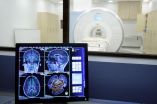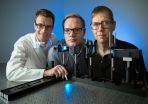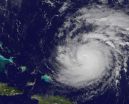Pharmaceuticals and the water-fish-osprey food web
2014-10-21
(Press-News.org) PENSACOLA, Fla. – Ospreys do not carry significant amounts of human pharmaceutical chemicals, despite widespread occurrence of these chemicals in water, a recent U.S. Geological Survey (USGS) and Baylor University study finds. These research findings, published by Integrated Environmental Assessment and Management is the first published study that examines the bioaccumulation of pharmaceuticals in the water-fish-osprey food web.
Pharmaceuticals have been finding their way into the environment, primarily through wastewater, urban runoff and even biosolids applied to agricultural lands. The impact on wildlife is unknown. Ospreys occupy the top of the food web, often nest in highly industrialized or urban areas, and eat only fish, making them an ideal sentinel for monitoring localized contaminants.
Rebecca Lazarus and her colleagues at the USGS conducted water analyses from 12 sites in the Chesapeake Bay area, and drew blood samples from fish and osprey nestlings living along surrounding waterways.
Not unexpectedly, the concentrations of pharmaceuticals in the water and fish were greatest in locations near wastewater treatment plants and in highly urbanized areas. However, of the 18 compounds found in water samples, only 7 pharmaceuticals and the artificial sweetener sucralose were found in fish. Sucralose was the only non-pharmaceutical chemical sampled, and it serves as an effective marker for of human activity. Only one compound was found at detectable levels in osprey blood plasma, which indicates these compounds are not generally being transferred up the food web.
"Only the antihypertensive drug diltiazem was detected in the blood of all sampled osprey nestlings, and was present at very low concentrations," said Lazarus. "The thresholds for this drug are unknown in ospreys at this time, and there is no overt evidence to suggest adverse effects."
The study was complemented by an exposure model that predicted 15 compounds out of a suite of 113 pharmaceuticals have the potential to exceed a human therapeutic dose and this hypothesis warrants further investigation. This type of model may be helpful for identifying additional compounds that may be detectable in wildlife.
INFORMATION:
For the full article, visit: http://onlinelibrary.wiley.com/doi/10.1002/ieam.1570/abstract
[Attachments] See images for this press release:

ELSE PRESS RELEASES FROM THIS DATE:
2014-10-21
JACKSONVILLE, Fla. — After following breast cancer patients for an average of eight-plus years, researchers say that adding trastuzumab (Herceptin) to chemotherapy significantly improved the overall and disease-free survival of women with early stage HER2-positive breast cancer.
They found that the use of trastuzumab produced a 37 percent improvement in survival and a 40 percent reduction in risk of cancer occurrence, compared to patients treated with chemotherapy alone.
These findings, published in the Journal of Clinical Oncology, demonstrate how important ...
2014-10-21
A new study, which may have implications for approaches to education, finds that brain mechanisms engaged when people allow their minds to rest and reflect on things they've learned before may boost later learning.
Scientists have already established that resting the mind, as in daydreaming, helps strengthen memories of events and retention of information. In a new twist, researchers at The University of Texas at Austin have shown that the right kind of mental rest, which strengthens and consolidates memories from recent learning tasks, helps boost future learning.
The ...
2014-10-21
ANN ARBOR, Mich. — Scientists have restored the hearing of mice partly deafened by noise, using advanced tools to boost the production of a key protein in their ears.
By demonstrating the importance of the protein, called NT3, in maintaining communication between the ears and brain, these new findings pave the way for research in humans that could improve treatment of hearing loss caused by noise exposure and normal aging.
In a new paper in the online journal eLife, the team from the University of Michigan Medical School's Kresge Hearing Research Institute and ...
2014-10-21
PHILADELPHIA – Blue light can both set the mood and set in motion important biological responses. Researchers at the University of Pennsylvania's School of Medicine and School of Arts and Sciences have teased apart the separate biological responses of the human eye to blue light, revealing an unexpected contest for control. Their work addresses the properties of melanopsin, a light-sensitive protein in the eye that establishes the rhythm of our day-night cycle and the familiar constriction of the pupil to bright light. They measured the pupil response to stimulation ...
2014-10-21
WASHINGTON, DC – October 20, 2014 -- Lactobacillus species, commonly seen in yogurt cultures, correlate, in the guts of mouse models, with mitigation of lupus symptoms, while Lachnospiraceae, a type of Clostridia, correlate with worsening, according to research published ahead of print in Applied and Environmental Microbiology. "Our results suggest that the same investigation shold be performed in human subjects with lupus," says principal investigator Xin Luo of Virginia Tech, Blacksburg, VA.
In the study, the investigators first showed that mouse models of lupus ...
2014-10-21
Tropical Storm Gonzalo strengthened into a hurricane on Oct. 14 when it was near Puerto Rico and provided a natural laboratory for the next phase of NASA's HS3 or Hurricane and Severe Storm Sentinel mission.
The WB-57 aircraft flew over Hurricane Gonzalo on Oct. 15 carrying two HS3 mission instruments called HIWRAP and HIRAD in addition to a new Office of Naval Research sponsored dropsonde system.
The WB-57 is a mid-wing, long-range aircraft capable of operation for extended periods of time from sea level to altitudes in excess of 60,000 feet. Two crew members are positioned ...
2014-10-20
For treating patients with prescription opioid dependence in primary care, buprenorphine maintenance therapy is superior to detoxification, according to a new study by Yale School of Medicine researchers published in the Oct. 20 issue of JAMA Internal Medicine.
Prescription opioid dependence has been increasing for the last 15 years and now surpasses heroin dependence. Doctors are also writing more prescriptions for pain management, which has led to higher experimentation and addiction rates, according to lead author David Fiellin, M.D., professor of internal medicine ...
2014-10-20
Scientists have developed new geochemical tracers that can identify hydraulic fracturing flowback fluids that have been spilled or released into the environment.
The tracers have been field-tested at a spill site in West Virginia and downstream from an oil and gas brine wastewater treatment plant in Pennsylvania.
"By characterizing the isotopic and geochemical fingerprints of enriched boron and lithium in flowback water from hydraulic fracturing, we can now track the presence of 'frac' fluids in the environment and distinguish them from wastewater coming from other ...
2014-10-20
LIVERMORE, Calif. – New medications created by pharmaceutical companies have helped millions of Americans alleviate pain and suffering from their medical conditions. However, the drug creation process often misses many side effects that kill at least 100,000 patients a year, according to the journal Nature.
Lawrence Livermore National Laboratory researchers have discovered a high-tech method of using supercomputers to identify proteins that cause medications to have certain adverse drug reactions (ADR) or side effects. They are using high-performance computers ...
2014-10-20
Preexisting differences in the sensitivity of a key part of each individual's immune system to stress confer a greater risk of developing stress-related depression or anxiety, according to a study conducted at the Icahn School of Medicine at Mount Sinai and published October 20 in the Proceedings of the National Academy of Sciences (PNAS).
Inflammation is the immune system's response to infection or disease, and has long been linked to stress. Previous studies have found depression and anxiety to be associated with elevated blood levels of inflammatory molecules ...
LAST 30 PRESS RELEASES:
[Press-News.org] Pharmaceuticals and the water-fish-osprey food web





